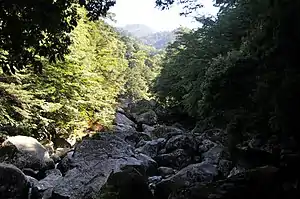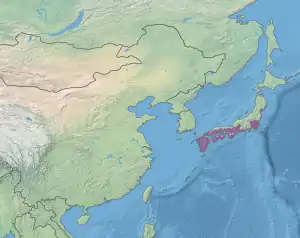Taiheiyo evergreen forests
The Taiheiyo evergreen forests is a temperate broadleaf forest ecoregion of Japan.
| Taiheiyo evergreen forests | |
|---|---|
 Nametoko Ravine in Ashizuri-Uwakai National Park | |
 | |
| Ecology | |
| Realm | Palearctic |
| Biome | temperate broadleaf and mixed forests |
| Borders | Nihonkai evergreen forests, Nihonkai montane deciduous forests, and Taiheiyo montane deciduous forests |
| Geography | |
| Area | 135,819 km2 (52,440 sq mi) |
| Country | Japan |
| Conservation | |
| Conservation status | Critical/endangered |
| Protected | 23,487 km² (17%)[1] |
Geography
The ecoregion covers an area of 138,300 square kilometers (53,400 sq mi) on the Pacific (Taiheiyo) side of the islands of Honshū, Shikoku, and Kyūshū. It also includes Tsushima Island in the Korea Strait between Kyushu and Korea, and the volcanic Izu Islands off Honshu's southern coast.[2]
The ecoregion is home to Japan's largest cities, including Tokyo, Yokohama, Osaka, and Nagoya.
Climate
The ecoregion has a humid subtropical climate. The influence of the Japan Current creates a humid climate with mild winters and a long growing season, which nurtured evergreen broadleaf forests.
Flora
Laurel forests grew near the coast, and Oak forests were predominant inland. At higher elevations, the Taiheiyo evergreen forests yielded to the Taiheiyo montane deciduous forests of the interior.[2]
The forests include a mix of species with origins in temperate and tropical Asia. Species with tropical origins include two species of the conifer Podocarpus, two species of Pittosporum, several species in the Laurel family (Machilus, Neolitsea, and Cinnamomum), and the Cycad Cycas revoluta. Trees with origins in temperate Eurasia include species of evergreen Oaks and Castanopsis.[3]
Fauna
Native mammals include the Sika deer (Cervus nippon) and Japanese macaque (Macaca fuscata),
Native birds include the fairy pitta (Pitta nympha) and Japanese night heron (Gorschius goisagi).
The terrestrial Odaigahara salamander (Hynobius boulengeri) is native to the ecoregion.
Conservation and threats
Most of forests have been converted to agriculture or cities. Remnant areas of forest remain around temples and shrines, on steep slopes, and in gorges. Secondary growth woodlands, called Satoyama, are found on hillsides bordering farmlands.[2]
Protected areas
17% of the ecoregion is in protected areas.[1] Protected areas include Fuji-Hakone-Izu National Park, Ise-Shima National Park, Yoshino-Kumano National Park, Seto Inland Sea National Park, Ashizuri-Uwakai National Park, Kirishima-Kinkowan National Park, Unzen-Amakusa National Park, Saikai National Park, and Suigō-Tsukuba Quasi-National Park (349.56 km²).[4][5]
See also
References
- Dinerstein, Eric; Olson, David; et al. (June 2017). "An Ecoregion-Based Approach to Protecting Half the Terrestrial Realm". BioScience. 67 (6): 534–545. doi:10.1093/biosci/bix014.CS1 maint: date and year (link) Supplemental material 2 table S1b.
- World Wildlife Fund, ed. (2001). "Taiheiyo evergreen forests". WildWorld Ecoregion Profile. National Geographic Society. Archived from the original on 2010-03-08. Retrieved September 5, 2010.
- Haggett, Peter (2002). Encyclopedia of World Geography (2nd ed.). Tarrytown, New York: Marshall Cavendish Co. p. 3089.
- "Taiheiyo evergreen forests". Digital Observatory for Protected Areas Explorer 4. Accessed 31 October 2020.
- UNEP-WCMC (2020). Protected Area Profile for Japan from the World Database of Protected Areas, October 2020. Available at: www.protectedplanet.net
External links
- "Taiheiyo evergreen forests". Terrestrial Ecoregions. World Wildlife Fund.